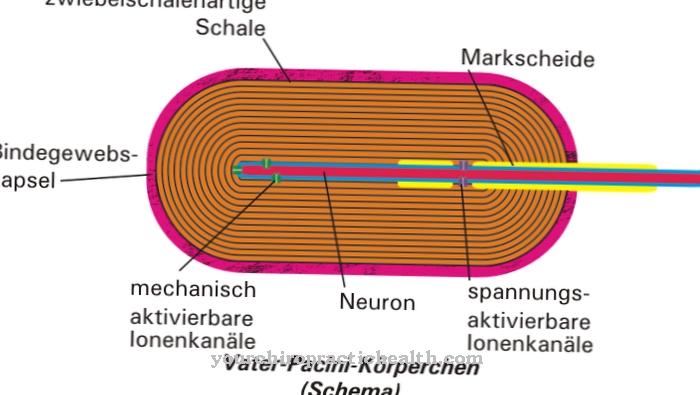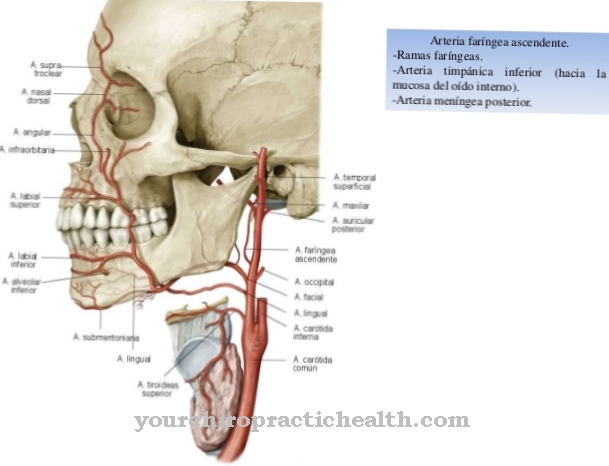The Vena lumbalis ascendens is an ascending blood vessel that runs alongside the spine. In the right half of the body it flows into the azygos vein, while it flows into the hemiazygos vein on the left. The ascending lumbar vein can represent a bypass circuit in the case of an embolism of the inferior vena cava (inferior vena cava).
What is the ascending lumbar vein?
The ascending lumbar vein is a blood vessel in the body's circulation. The vein transports deoxygenated blood towards the heart, from where the body pumps the blood into the lungs.
There the red blood cells (erythrocytes) take up oxygen and distribute it in the various organs and tissues of the organism. The ascending lumbar vein occurs in both halves of the body. The anatomy differentiates between the vena lumbalis ascendens dextra (right) and the vena lumbalis ascendens sinistra (left). Since the human body is not completely symmetrical and the heart is shifted to the left in most people, the two blood vessels follow a slightly different course.
Anatomy & structure
The ascending lumbar vein runs under the lumbar muscle (psoas major and psoas minor muscles) on both the right and left sides. There it runs in front of the costal processes, at the level of the lumbar vertebrae. The ascending lumbar vein crosses the lumbar region between the iliac crest and the lowest rib.
The ascending lumbar vein flows on the right side of the body into the azygos vein, which runs in the area of the thoracic spine. The azygos vein passes through the lumbar gap (pars lumbalis diaphragmatis) and flows into the superior vena cava (superior vena cava). Previously, various other veins flow into the azygos vein, including the hemiazygos vein. This comes from the left half of the body and also takes the blood from the left ascending lumbar vein. The blood reaches the right atrium from the superior vena cava.
The ascending lumbar vein has a wall that consists of three layers in cross section. The innermost vein wall is the tunica interna, which has a layer of endothelial cells. These line the inside of the blood vessel. The venous valves also belong to the tunica interna. Above this lies the tunica media, in which there is a layer of smooth muscles. The tunica externa forms the outer layer of the vein wall and is also known as the tunica adventitia.
Function & tasks
The ascending lumbar vein is connected to the lumbar vein. Normally they open into the inferior vena cava (inferior vena cava), which begins in the area of the lumbar spine, runs through the diaphragm and flows into the right atrium via the sinus venarum cavarum.
The ascending lumbar vein transports deoxygenated blood. In the human body, the red fluid moves within a closed circuit. The correct flow of blood is therefore of great importance. Since the ascending lumbar vein rises in the body, most of the time it has to carry the blood upwards against gravity. A thin layer of muscle in the vein wall helps her to do this. Venous valves protrude into the interior of the blood vessel and prevent the blood from flowing back.
The blood pressure within a vein is relatively low and is typically 0-15 mm Hg. For comparison: arteries in healthy people have an average blood pressure of 70-120 mm Hg. Because of this difference, medicine also speaks of the low-pressure system. In addition to the ascending lumbar vein and all other veins, this part of the cardiovascular system also includes parts of the heart, the pulmonary circulation and the fine capillary bed.
The low pressure system is used to store the blood. Its vessels give off more blood when the volume in the overall circulation decreases. This happens, for example, in the event of blood loss due to injury. As soon as the body has sufficient blood volume again, it fills the low-pressure system until it stores around 85% of the blood again.
You can find your medication here
➔ Medication for heartburn and bloatingDiseases
The ascending lumbar vein is connected to the lumbar vein, external iliac vein and iliolumbar vein on the one hand and to the superior vena cava on the other.
This allows it to contribute to a collateral circuit that bypasses the inferior vena cava. In this case, medicine speaks of a cavocaval anastomosis, where "anastomosis" denotes a connection and "kavocaval" refers to the vena cava. Such a bypass circuit is relevant if the blood flow in the inferior vena cava is no longer guaranteed, especially if the blood vessel is narrowed or blocked. The clinical phenomenon is also known as embolism and can have a number of causes.
A thrombus is made up of clotted blood platelets that clump together in the vessel. The blood components can be deposited, for example, on the venous valves or in protuberances in the vein wall. A lack of exercise, smoking, an unhealthy diet and other risk factors promote the development of a thrombus. If such a clot loosens, it can then get stuck in a smaller blood vessel or become jammed.
Another possible cause of a vein occlusion is gas embolism, in which gases are released from the blood and impede blood flow. Other forms of embolism include foreign bodies and the body's own tissues that may enter the vein if injured, for example. Tumors can also restrict blood flow.
The ascending lumbar vein can also be directly damaged by injuries to the back. In addition, other venous diseases such as inflammation (phlebitis) are generally possible.













.jpg)

.jpg)
.jpg)











.jpg)